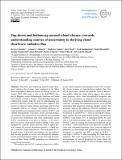| dc.contributor.author | Sanchez, Kevin J. | |
| dc.contributor.author | Roberts, Gregory C. | |
| dc.contributor.author | Calmer, Radiance | |
| dc.contributor.author | Nicoll, Keri | |
| dc.contributor.author | Hashimshoni, Eyal | |
| dc.contributor.author | Rosenfeld, Daniel | |
| dc.contributor.author | Ovadnevaite, Jurgita | |
| dc.contributor.author | Preissler, Jana | |
| dc.contributor.author | Ceburnis, Darius | |
| dc.contributor.author | O'Dowd, Colin | |
| dc.contributor.author | Russell, Lynn M. | |
| dc.date.accessioned | 2018-02-14T14:36:54Z | |
| dc.date.available | 2018-02-14T14:36:54Z | |
| dc.date.issued | 2017-08-22 | |
| dc.identifier.citation | Sanchez, K. J., Roberts, G. C., Calmer, R., Nicoll, K., Hashimshoni, E., Rosenfeld, D., Ovadnevaite, J., Preissler, J., Ceburnis, D., O'Dowd, C., and Russell, L. M.: Top-down and bottom-up aerosol–cloud closure: towards understanding sources of uncertainty in deriving cloud shortwave radiative flux, Atmos. Chem. Phys., 17, 9797-9814, https://doi.org/10.5194/acp-17-9797-2017, 2017 | en_IE |
| dc.identifier.issn | 1680-7324 | |
| dc.identifier.uri | http://hdl.handle.net/10379/7135 | |
| dc.description.abstract | Top-down and bottom-up aerosol-cloud shortwave radiative flux closures were conducted at the Mace Head Atmospheric Research Station in Galway, Ireland, in August 2015. This study is part of the BACCHUS (Impact of Biogenic versus Anthropogenic emissions on Clouds and Climate: towards a Holistic UnderStanding) European collaborative project, with the goal of understanding key processes affecting aerosol-cloud shortwave radiative flux closures to improve future climate predictions and develop sustainable policies for Europe. Instrument platforms include ground-based unmanned aerial vehicles (UAVs)(1) and satellite measurements of aerosols, clouds and meteorological variables. The ground-based and airborne measurements of aerosol size distributions and cloud condensation nuclei (CCN) concentration were used to initiate a 1-D microphysical aerosol-cloud parcel model (ACPM). UAVs were equipped for a specific science mission, with an optical particle counter for aerosol distribution profiles, a cloud sensor to measure cloud extinction or a five-hole probe for 3D wind vectors. UAV cloud measurements are rare and have only become possible in recent years through the miniaturization of instrumentation. These are the first UAV measurements at Mace Head. ACPM simulations are compared to in situ cloud extinction measurements from UAVs to quantify closure in terms of cloud shortwave radiative flux. Two out of seven cases exhibit sub-adiabatic vertical temperature profiles within the cloud, which suggests that entrainment processes affect cloud microphysical properties and lead to an overestimate of simulated cloud shortwave radiative flux. Including an entrainment parameterization and explicitly calculating the entrainment fraction in the ACPM simulations both improved cloud-top radiative closure. Entrainment reduced the difference between simulated and observation-derived cloud-top shortwave radiative flux (delta RF) by between 25 and 60Wm(-2). After accounting for entrainment, satellite-derived cloud droplet number concentrations (CDNCs) were within 30% of simulated CDNC. In cases with a well-mixed boundary layer, delta RF is no greater than 20Wm(-2) after accounting for cloud-top entrainment and up to 50Wm(-2) when entrainment is not taken into account. In cases with a decoupled boundary layer, cloud microphysical properties are inconsistent with ground-based aerosol measurements, as expected, and delta RF is as high as 88Wm(-2), even high (> 30Wm(-2)) after accounting for cloud-top entrainment. This work demonstrates the need to take in situ measurements of aerosol properties for cases where the boundary layer is decoupled as well as consider cloud-top entrainment to accurately model stratocumulus cloud radiative flux. | en_IE |
| dc.description.sponsorship | The research leading to these results received
funding from the European Union’s Seventh Framework
Programme (FP7/2007-2013) project BACCHUS under grant
agreement no. 603445. EU H2020 project ACTRIS-2 under the
grant agreement no. 654109 is also acknowledged for supporting
the Mace Head Atmospheric Research Station. Keri Nicoll
acknowledges a NERC Independent Research Fellowship
(NE/L011514/1). Darius Ceburnis acknowledges the Irish EPA
(2012-CCRP-FS.12). Jana Preissler acknowledges the Irish EPA
(2015-CCRP-FS.24). Radiance Calmer acknowledges financial
support from Météo France. Kevin J. Sanchez acknowledges the
Chateaubriand Fellowship. We thank École Nationale de l’Aviation
Civile (ENAC) for assistance with construction and operation of
the UAVs. The authors also acknowledge Kirsten Fossum for the
collection of SMPS data. We applied a sequence-defines-credit
approach for the sequence of authorship. | en_IE |
| dc.format | application/pdf | en_IE |
| dc.language.iso | en | en_IE |
| dc.publisher | European Geosciences Union (EGU) | en_IE |
| dc.relation.ispartof | Atmospheric Chemistry And Physics | en |
| dc.rights | Attribution-NonCommercial-NoDerivs 3.0 Ireland | |
| dc.rights.uri | https://creativecommons.org/licenses/by-nc-nd/3.0/ie/ | |
| dc.subject | MARINE BOUNDARY-LAYER | en_IE |
| dc.subject | MACE HEAD | en_IE |
| dc.subject | CONDENSATION NUCLEI | en_IE |
| dc.subject | CONVECTIVE CLOUDS | en_IE |
| dc.subject | DROP CONCENTRATION | en_IE |
| dc.subject | SIZE DISTRIBUTION | en_IE |
| dc.subject | LIGHT-SCATTERING | en_IE |
| dc.subject | COASTAL AEROSOL | en_IE |
| dc.subject | MIXED LAYERS | en_IE |
| dc.subject | ACE 1 | en_IE |
| dc.title | Top-down and bottom-up aerosol-cloud closure: towards understanding sources of uncertainty in deriving cloud shortwave radiative flux | en_IE |
| dc.type | Article | en_IE |
| dc.date.updated | 2018-02-14T11:08:06Z | |
| dc.identifier.doi | 10.5194/acp-17-9797-2017 | |
| dc.local.publishedsource | http://dx.doi.org/10.5194/acp-17-9797-2017 | en_IE |
| dc.description.peer-reviewed | peer-reviewed | |
| dc.contributor.funder | European Union’s Seventh Framework
Programme (FP7/2007-2013) | |
| dc.contributor.funder | EU H2020 | |
| dc.internal.rssid | 13159526 | |
| dc.local.contact | Darius Ceburnis, School Of Physics, Room 215a Arts/Science Building, Nui Galway. 2496 Email: darius.ceburnis@nuigalway.ie | |
| dc.local.copyrightchecked | Yes | |
| dc.local.version | PUBLISHED | |
| nui.item.downloads | 347 | |


